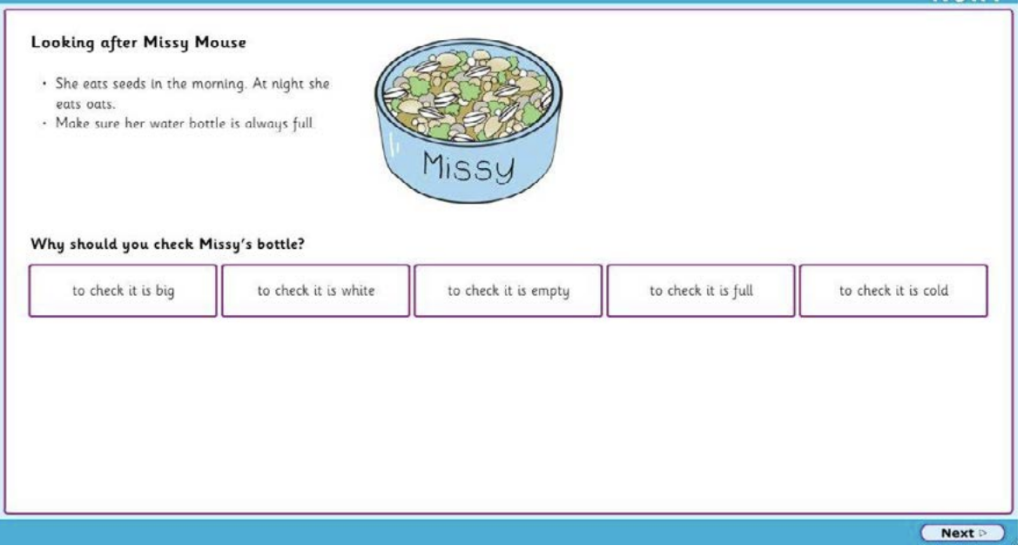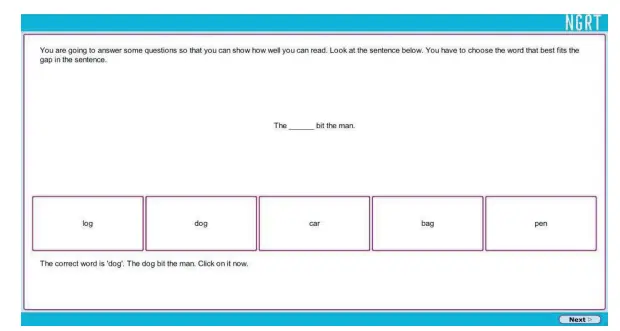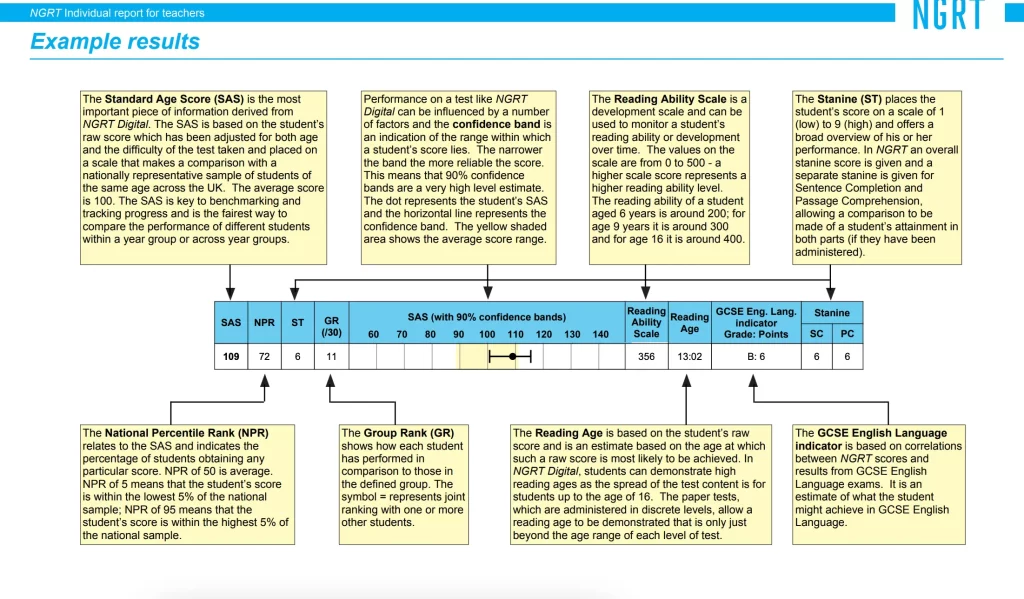Reading is a cornerstone of learning, opening doors to knowledge and imagination.
At Spark Generation, we recognise the profound impact that a solid foundation in reading can have on a student’s educational journey.
That’s why we advocate for the New Group Reading Test (NGRT), a comprehensive assessment designed to measure and fully understand each child’s reading abilities.
What is NGRT?
The New Group Reading Test (NGRT) is like a reading check-up for students aged 6 to 16.
It helps parents & teachers see how students’ reading levels compare against others in their age group nationwide.
The test has different parts that look at:
- how well students can sound out words (phonics)
- understand what they’re reading (comprehension)
- figure out words they might not know (decoding)
- understand grammar and vocabulary
Depending on the student’s age and which test version they’re taking, it might also check how well they can guess meanings from context, understand what the author is trying to say, and get the hang of expressions and language that aren’t meant to be taken literally.

When should students take the NGRT?
For Educators:
If you are an educator who uses the NGRT as an assessment tool to test the reading levels in your class, you should consider administering the test at least 2 times/academic year.
Once at the beginning of the academic year – to test students’ reading & comprehension levels and once at the end of the academic year to see if any progress has been made.
For Parents:
We recommend testing your child with the NGRT at the beginning of their secondary school journey to get an idea of their reading level as well as any possible learning difficulties or needs.
This test can be a great tool for any educational counsellors, parents, or guardians looking to understand reading & comprehension skills and plan for an adequate education based on the results.
How NGRT Works
Administered through an engaging digital platform, the NGRT test provides immediate insights into a student’s reading level.
The test includes filling-in-the-blanks exercises, understanding stories or passages, and some exercises focused on phonics.
But the NGRT isn’t just about seeing if students can read the words in front of them; it’s about making sure they can understand and make sense of those words, too.
The digital version of the NGRT has three main sections:
- phonics
- Sentence completion
- passage comprehension
The test is easily adaptable, and each student’s performance is measured as they complete it. The questions are adapted to align with the ability they demonstrate.
This means that students with weak skills can be tested with material at a lower level than that determined by their age, and students with high-level skills can be tested with material that better reflects their ability.
Testing Process
Students start the testing with an exercise according to their age. All start with the sentence completion section.
Depending on the score from this part of the test, they will be moved on to the
passage comprehension section or be given the phonics tasks.
Those who complete the phonics tasks will not be presented with the passage comprehension.
Testing time will be approximately 30 minutes.

Getting the NGRT Results
Step 1: Receiving the Results
You’ll receive a digital report.
The report covers sections like Phonics, Sentence Completion, and Passage Comprehension, reflecting the student’s performance.
Step 2: Key Components of the Report
Overview of Sections Tested:
- Phonics: Focuses on sound-letter combinations.
- Sentence Completion: Assesses vocabulary and grammatical understanding.
- Passage Comprehension: Measures understanding of text and inference abilities.
Scores Explained:
- Standard Age Score (SAS): Compares your child’s performance against a national average. The average score is 100.
- Reading Age: An estimate of the reading capability level expected for a certain age.
- Stanine (ST): Ranks performance on a scale of 1 to 9, providing a broad view of where the student stands.
- National Percentile Rank (NPR): Shows how the student scores compared to peers nationwide.
- GCSE English Language Indicator: Predicts potential performance in GCSE English based on current reading abilities.
Analysis & Comparison:
The report visually presents the student’s scores, confidence bands (showing reliability), and comparison to national averages.
Step 3: Interpreting the Results
- Understanding Strengths and Areas for Improvement: The report highlights both to help tailor future learning.
- Progress Monitoring: Use the Reading Ability Scale to track development over time.
- Educational Planning: Scores help decide the level of support or enrichment needed.

Benefits of NGRT for Students
The NGRT test is more than just an assessment—it’s a roadmap to a successful reading journey.
- Identifies Strengths and Weaknesses: By highlighting what students excel at and where they need more help, the NGRT ensures that every child gets the support they need to grow.
- Tailored Support: With the insights gained from the test, educators can provide personalised assistance that targets the student’s specific needs, making learning more effective and enjoyable.
- Boosts Confidence: Recognising and celebrating areas of strength helps build students’ self-esteem. As they see their reading improve, their confidence in their abilities grows.
- Fosters a Love for Reading: By making reading less of a challenge and more of an adventure, students are more likely to develop a lifelong passion for reading.
- Prepares for Future Success: Strong reading skills are fundamental to academic achievement across all subjects. The NGRT helps lay the groundwork for future educational success.
- Encourages Progress Tracking: The test provides a baseline to measure growth over time, encouraging students to set goals and strive for improvement.
- Adaptable Difficulty: Since the test adjusts to each student’s level, it ensures that the assessment is neither too easy nor too hard, making the experience positive and encouraging.
- Immediate Feedback: Quick results mean that students and educators can start working on improvement strategies without delay, keeping motivation high.
Benefits of NGRT for Parents
The NGRT test provides parents with a valuable window into their child’s reading skills, offering benefits that extend far beyond the classroom.
- The NGRT sheds light on where your child stands in reading, highlighting their strengths and areas that need improvement.
- Parents can make well-informed choices about their child’s education, selecting the right resources and interventions to support their learning journey.
- The test’s results help parents identify the best ways to assist their child’s reading development at home through specific exercises, choosing suitable reading materials, or other educational activities.
- The NGRT provides a professional assessment tool for homeschooling parents and families to benchmark their child’s reading level against national standards, guiding curriculum choices and teaching strategies.
These advantages highlight the NGRT’s role not just in assessing reading skills but in strengthening the educational support system around each child, tailored to their unique needs.
Integrating NGRT into Learning Strategies
With the insights gained from the NGRT, educators and parents can collaborate to design personalised learning strategies that resonate with each child’s reading profile.
At Spark Generation, we like to start each student’s learning journey by suggesting that they go through the necessary testing and steps to ensure that we tailor the best-fitting education around them: their needs and goals.
Do you know what are the educational needs of your teenager? What about their goals?
Help them discover their strengths and get an education that is tailored to their abilities and needs by taking the NGRT.
As soon as you complete payment, our team will contact you and send you the details for taking the test using the contact information you provided.
Curious about how we interpret and integrate the NGRT results in your child’s learning journey at Spark Generation?
☎️Get in touch with our Admissions team, and we’ll tell you more about it!
FAQs About NGRT
1. What does NRGT assess?
The NGRT has two main parts: sentence completion, which checks understanding and decoding of text, and passage comprehension, evaluating deeper comprehension skills. It assesses how well students can read words and understand their meaning, which is useful for tracking phonemic awareness in emerging readers.
The test provides reading ages and Standard Age Scores, aiding in tailoring curriculum difficulty and identifying students needing extra support or challenge, especially useful during key educational transitions.
2. What makes NGRT different from other reading assessments?
NGRT stands out due to its comprehensive approach to assessing decoding, comprehension, and fluency. This allows for a nuanced understanding of a child’s reading abilities, facilitating targeted interventions.
3. How often should students take the NGRT test?
We recommend annual testing to track progress and adjust learning strategies as needed. Regular assessment ensures that interventions remain aligned with the child’s evolving needs.
4. Can NGRT results help in selecting the right educational programs or interventions?
Absolutely. NGRT results provide a detailed picture of a child’s reading skills, guiding educators and parents in choosing the most effective programs and interventions to support the child’s growth.
5. What should parents do after receiving their child’s NGRT results?
Engage with your child’s educators to understand the results fully and discuss possible next steps. Explore Spark Generation’s resources and programs designed to address specific reading challenges and enhance overall learning. Contact us for guidance.
6. What can I do if NGRT highlights concerns in my student’s reading levels?
If a student scores less than 85 on NGRT, use the York Assessment of Reading for Comprehension (YARC) to further diagnose reading difficulties, including reading accuracy, comprehension, and rate.
If there is a significant difference between sentence completion and passage comprehension in NGRT, screen for dyslexic tendencies using Rapid (ages 4-15), CoPS (ages 4-7) or LASS (ages 8-15).




